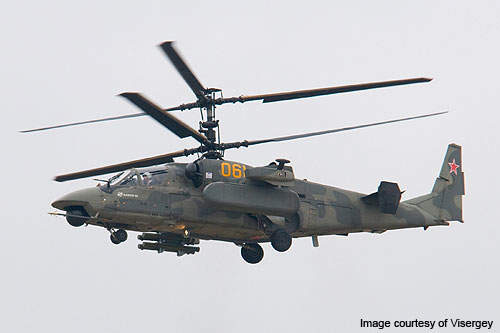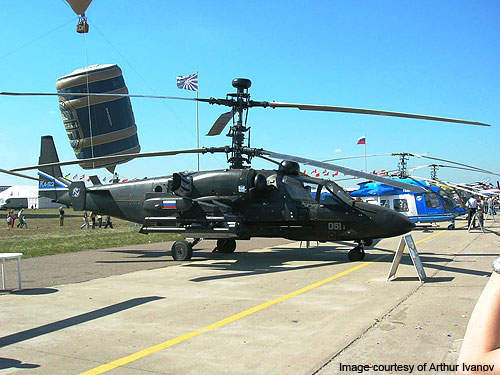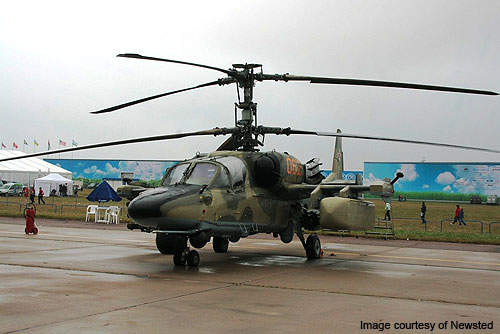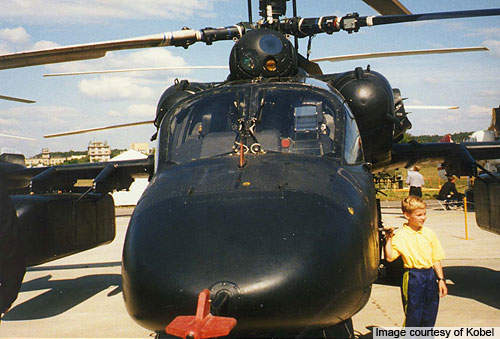Kamov Ka-52 Alligator (NATO reporting name: Hokum B) is an all-weather combat helicopter developed by Kamov Design Bureau. The Ka-52 is a twin-seat version of the Ka-50 helicopter. It has been designed to attack armoured and unarmoured ground targets and low-speed air targets.
The first airframe construction of Ka-52 began in mid 1996 and the first finished helicopter rolled out in December 1996. The aircraft took its maiden flight in June 1997. Serial production commenced in October 2008.
The helicopter complies with Russian and international regulations for military helicopters. It can perform combat operations, day or night, in all weather conditions. It can also be used as a training helicopter.
Russia placed an order for 36 Ka-52s in late 2009. First batch of three production helicopters was handed over to the Russian Army Aviation Combat and Conversion Training Centre (CCTC) in Torzhok in December 2010. Russia ordered more than 140 Ka-52 helicopters for its air force in September 2011.
Russia plans to equip the French-built Mistral-class assault ships with Ka-52 helicopters by the end of 2012.
Ka-52 design and features
Based on the Ka-50 airframe, the front fuselage section of the Ka-52 was redesigned to incorporate a two-seat side-by-side cockpit. The Ka-52 features a wider nose due to reduced cockpit armour and the nose-mounted radome. The 30mm cannon and six wing-mounted hardpoints of the Ka-50 were retained in the Ka-52. The helicopter has a catapult crew rescue system integrating an ejection and rocket-parachute.
Two radar systems are mounted, one for aerial targets and another for ground targets, on the mast and nose respectively. Samshite night / daytime thermal sighting system is housed in two spherical turrets, one above the cockpit and the other below the nose. The electronic devices fitted to the helicopter largely reduce the chances of it being visible to enemy forces.
The helicopter has TV, FLIR, and laser range-finder, and target designator.
The FLIR is integrated with a Shkval electro-optical sighting system. A ball-shaped structure is fitted under the fuselage for optical sight and windows are provided in the nose turret for the laser range-finder and IR camera.
Avionics
The multi-functional avionics suite of Ka-52 consists of a multi-level digital computer-based system, a Topowl helmet-mounted sight display, observation, search and targeting systems. The multiplexed bus system coordinates several tasks including piloting, navigation and weapons control on the battlefield. Other systems include navigation and attack system for helicopters (NASH) and Nadir 10 navigation system.
The built-in control mechanism allows the crew to operate the helicopter in an autonomous mode in field conditions. On-board flight information is displayed on two colour and two monochrome multi-function displays.
Weapon systems
The Ka-52 has six external wing stores for anti-tank missiles, rockets and air-to-air missiles. The helicopter is armed with six laser-guided Vikhr anti-tank missiles and two B8V-20 rocket pods for S-8 80mm air-to-surface rockets.
The Vikhr missile can engage armoured ground targets within the range of 8km to 10km. Twin Igla missile launchers fitted under each wingtip countermeasure pod can fire four Igla light air-to-air missiles.
A 30mm Shipunov 2A42 automatic cannon is fitted on the starboard side of the fuselage. The gun has a dual feed for HE-T and AP-T rounds.
It can engage ground targets within a range of 1,500m as well as low flying targets within a slant range of 2,500m.
Countermeasures
The Ka-52 features electronic protection and means of active countermeasures. The helicopter is equipped with active IR and electronic jamming units, Pastel (L150) RWR, Mak (L136) IR and Otklik (L140) laser warning systems. UV-26 flare / chaff dispensers fitted on wingtip fairings can fire flare / chaff decoys to deceive incoming anti-aircraft missiles.
Engines
Ka-52 is powered by two VK-2500 (TV3-117VMA-SB3) turbo-shaft engines rated at 1,863kW. The prototype is fitted with two TV3-117VMA turbo-shaft engines. The fuel tanks are made of explosion-proof materials.
Ka-52 performance
The Ka-52 can fly at a maximum speed of 310km/h. Cruising and lateral speeds of the helicopter are 250km/h and 80km/h respectively. The maximum take-off weight is 10,800kg. The helicopter can climb at a rate of 10m/s to a maximum altitude of 3,600m. The practical flight range is 520km. The helicopter can perform flight operations within the minimum air space and gain an attack position in less time.
The Global Military Rotorcraft Market 2011-2021
This project forms part of our recent analysis and forecasts of the global military rotorcraft market available from our business information platform Strategic Defence Intelligence. For more information click here or contact us: EMEA: +44 20 7936 6783; Americas: +1 415 439 4914; Asia Pacific: +61 2 9947 9709 or via email.








